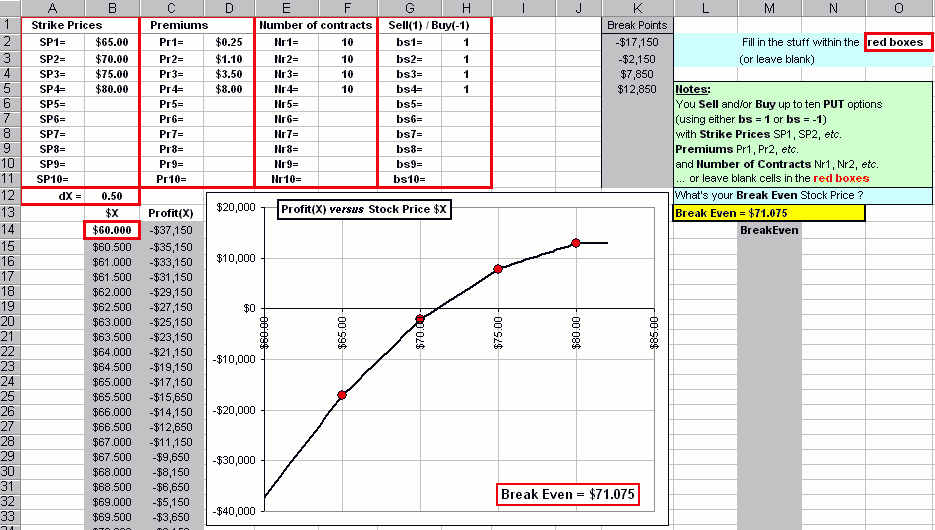| PUT Options ... and Break Even Stock Price |
Mike was interested in buying and Selling PUT options (up to ten contracts per stock) ... and what the formula was for the Break Even stock price.
>And you told him?
Uh ... no. I don't know any formula, but one can determine the Break Even price with an Excel spreadsheet.
First we note the following, for the Buyer of a PUT Option:
- If the Strike Price of a PUT option is SP, then a person buying a PUT will be able to sell it for $SP
(anytime she wishes, before it expires). - For this privilege, she pays a premium of Pr.
- If the Stock Price, X, is less than SP and the buyer exercises her option, she sells the stock at SP and can immediately buy it at X.
- Her profit is then (SP - X) - Pr subtracting the cost of buying the option: Pr
- If the Stock Price is never less than the Strike Price, then she won't sell the stock at the X (since it's worth more, namely SP, in the market)
In this case, her profit is 0 - Pr which, of course, is a loss! - In general, then, her PROFIT is: MAX(SP - X, 0) - Pr where MAX means the MAXimum of the two values
Now, for the Seller ...
>You mean the guy who writes the option?
Yes ... but I'll call him the Seller. As I was saying:
Now, for the Seller of a PUT Option:
- The seller of the PUT receives the premium of Pr regardless of whether the option is exercised.
- If the Stock Price, X, is less than SP and the option buyer exercises her option, the seller of the PUT must buy the stock at SP even though it's only worth X in the market.
- His profit is then (X - SP) + Pr adding the loss (X - SP) from the Premium he receives
- If the Stock Price is never less than the Strike Price, then he won't be buying any stock (!)
In this case, his profit is just the premium, namely: Pr. - In general, then, his PROFIT is: MIN(X - SP, 0) + Pr where MIN means the Minimum of the two values
Comparing the two profit formulas, we can write the profit for both the Buyer and the Seller as:
>bs?
Note, too, that we could also write: PROFIT = bs {- MAX(SP - X, 0) + Pr}. >What about fees and commissions and ...?
|  |
>So, what's that Break Even Stock Price?
That ain't easy. If you Buy and Sell several options, the PROFIT chart is a series of connected line segments.
For Break Even, we want the Stock Price, X, where PROFIT = 0.
For several Buy/Sell, we can use an Excel spreadsheet.
Suppose we're Selling (or "writing") four put options (so bs = 1), each involving Nr = 10 contracts (a "contract" is 100 stock shares) where:
- The Strike Prices are SP1 = $65, SP2 = $70, SP3 = $75 and SP4 = $80
- The Premiums are Pr1 = $0.25, Pr2 = $1.10, Pr3 = $3.50 and Pr4 = $8.00
- The Number of contracts are Nr1 = 10, Nr2 = 10, Nr3 = 10 and Nr4 = 10
100*bs Nr {MIN(X - SP, 0) + Pr} with bs = 1 and Nr the Number of contracts.
In other words, for our four options, it's:
100* {Nr1[ MIN(X-SP1, 0)+Pr1 ] + Nr2[ MIN(X-SP2, 0)+Pr2 ]+ Nr3[ MIN(X-SP3, 0)+Pr3 ] + Nr4[ MIN(X-SP4, 0)+Pr4 ] }
The spreadsheet might look like so:

Note the strange, broken-line chart of PROFIT the breaks occur at the Strike Prices
Each segment is a straight line so that we may find the place where PROFIT = 0 by identifying where the PROFIT changes sign.
|
Suppose that occurs at (X,0), between (X1, Y1) and (X2, Y2). Then (because the graph is a straight line segment between Strike Prices), the spreadsheet equates slopes, getting (0 - Y1) / (X - X1) = (Y2 - Y1) / (X2 - X1)
X = X1 - Y1*(X2 - X1) / (Y2 - Y1) >Can there be more than one break even?
Click here for an example.
|  |
To download the spreadsheet, RIGHTclick on the picture of the spreadsheet (above) ... then Save Target.
>I assume there's a money-back guarantee on the accuracy?
Always.


